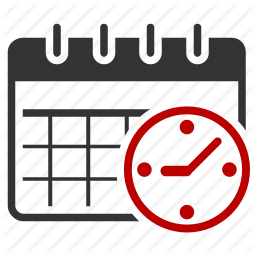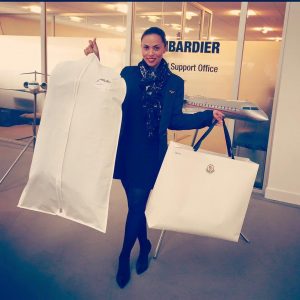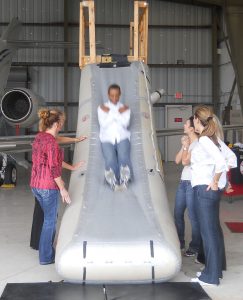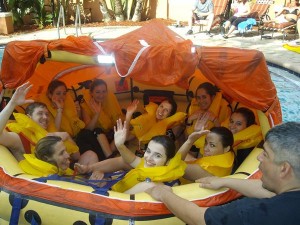 How to become a flight attendant: Popular Guide
How to become a flight attendant: Popular Guide
Flight attendants or cabin crew (also known as stewards/stewardesses, air hosts/hostesses, cabin attendants) are members of a flight crew employed by airlines, corporate and private aircraft who’s main function is to ensure the safety and comfort of passengers aboard commercial flights, on corporate jet aircraft, and on some military aircraft.
Guide Index: Commercial Flight Attendants & Corporate Flight Attendants
- Intro: Job Description for Flight Attendants->
- Flight Attendant Qualifications ->
- Flight Attendant Training ->
- Flight Attendant Salary ->
- Post Training Expectations ->
- Flight Attendant Schedule ->
- Flight Attendant Uniform ->
- Flight Attendant Benefits ->
- Flight Attendant Resume Sample ->
- Flight Attendant Interview Questions ->
- FAQs ->
General Job Description for Flight Attendants
Flight attendants are employed to ensure comfort and safety of airplane passengers. They provide culinary and beverage service on most flights. They also brief passengers about safety measures before and during flight operations. Flight attendants act as customer service liaison with travelers, answering questions about the flight and handling complaints. Finally, the attendants serve an important flight security role by observing passenger behavior and reporting and handling any problems to maintain a safe cabin for passengers and secure cockpit for pilots.
Much of a flight attendant’s role is within view of the air traveler. The attendants welcome guests aboard a flight and assist them in finding seating and storing carry-on luggage. They also handle the more complicated service involved with first-class or private passengers. They can assist with locating travel information for connecting flights and other travel services as well. Flight attendants ensure that during take-offs, landings, and turbulence, all passengers are properly strapped in and secured in seats.
Most flight attendants seek out training from vocational schools and training providers that offer specialized instruction in this career field. Many flight attendants have a college degree in hospitality or a related field. Flight attendants typically work in airports and on airplanes, so they travel daily.
The first thing to understand when it comes to becoming a flight attendant is the two separate sectors which you can pursue: Commercial or Corporate.
Commercial Flight Attendants: Are the individuals you first encounter when you board airlines such as Delta, Southwest, American, or United at a larger, international or commercial airport. Hundreds of thousands of individuals are employed as flight attendants every year to ensure cabin safety and comfort for commercial airlines on their scheduled routes every day. It is regulated by the FAA that there must be at least 1 crew member for every 50 passengers on a commercial airline.
Corporate Flight Attendants: Are the individuals you will encounter when you board a corporate business jet operated by a private owner or charter company out of smaller, executive airports. Thousands of individuals are employed as corporate flight attendants every year to ensure cabin safety and comfort for private, corporate or general aviation on flights that can occur at any given time. In general, there are only 1-2 corporate flight attendants per 19 seats or fewer, which is the number of passengers that classifies a general aviation flight.
Flight Attendant Qualifications
- Commercial Flight Attendant:
- Age Requirement – All flight attendants must be 18 years or older, however depending on the airline the minimum age may increase. This increase usually does not exceed 21. As far as maximum age, unless you are nearing retirement age, there is no reason you cannot become a flight attendant solely based off of age.
- Physical Attributes – Height, weight, reach, and vision are the four key features that are looked at when hiring a flight attendant. The traditional height range for flight attendants is 5’0-6’3. There is no specific weight minimum or maximum, however it is usually required that your weight is proportional to your height. Reach is normally directly related to your height, however your standing reach is becoming an increasingly used measurement for cabin success. Finally you must have 20/30 vision or better, which is less than normal vision, yet adequate enough with the use of eyeglasses or contact lenses.
- Personal Appearance – When it comes to commercial airlines,there are strict grooming regulations you must maintain to in order to stay within the branding of the airline and their company standards. It’s very much one of the basic flight attendant requirements: you really must “look like part of the aircraft”. For example: always maintain polished shoes, pressed and clean company uniform, always having your shirt tucked in and aovid having an outrageous hair color.
- Personality/Personal Characteristics – Communication is the number one aspect of working as a flight attendant as you are in constant exchange with passengers and pilots, including giving instructions to passengers in an emergency situation. Being able to work well under pressure, working well within a team, being patient, being attentive to customer service and satisfaction, and having a positive attitude are all major characteristics of a commercial flight attendant.
- Physical Ability – Being a flight attendant is a surprisingly demanding job, especially when you are on trips back to back with no breaks in between. Some of the day to day duties of a commercial flight attendant are: lifting heavy luggage into overhead compartments, pushing a 150+ pound service cart through the aisle, keeping balance when serving passengers and experiencing turbulence, walking the length of the airport pre and post flight, working in pressurized cabins with recycled air for hours at a time, coping with jet lag and sometimes sleep disruption, and working extended shifts.
- Language – English is the chosen language in aviation, however fluency in multiple languages is a definite advantage.
- Documentation – Valid Passport and further VISA’s may be required.
- Corporate Flight Attendant:
- Age Requirement – Much like their commercial counterpart, corporate flight attendants must be 18 years or older because of the possibility that they may serve alcohol while catering to the passengers. Each charter company or personal owner may have a specific age range that they prefer depending on the clientele and their preference. This can mean using an older flight attendant to help with children and other tasks that could involve more life experience.
- Physical Attributes – Height, weight, reach, and vision are the same requirements for a corporate flight attendant, with a slight variation. The average corporate flight attendant is slightly shorter than their commercial counterpart, due to the size of the business jet they operate on. However, each charter company or owner will have their own requirement depending on cabin measurements. Somtimes, shorter is better in corporate aviation. There is no weight limit in corporate aviation, however with the small working space you must be able to operate efficiently in the given area. Reach is also very important in corporate aviation, however with fewer passengers and seats, a longer reach is not always necessary to pass items. Finally the vision for a corporate flight attendant is also listed as 20/30, again attainable with the use of eyeglasses or contact lenses.
- Personal Appearance – When it comes to corporate aviation, the uniform standards are not nearly as tedious because of the lack of larger scale operations that require streamline branding and uniforms. However, the level of professionalism and attire could be classified as highly stylish professional, as the flight attendant on board will usually be the sole attendant and catering to a highest level of wealthy and famous clients. Conservative hairstyles, length, and color are recommended. Jewelry and accessories should be kept to a minimum, and no visible piercings are allowed except fine studs in the ears. Tattoos are not an issue as long as they are covered and out of view for the duration of the flight. White, black, navy, and red dress slacks, skirts, blouses, and jackets are the usual color combination worn in aviation as part of your job is also not draw attention to yourself.
- Personality/Personal Characteristics – In addition to being able to work under pressure, working within a team, being patient, being attentive, and being positive, there are additional personality traits that tend to gravitate to the private aviation industry. Corporate flight attendants must be flexible with their schedule, as flights are booked and changed as often as business meetings and business trips are made. Being able to multi-task is also very important as a corporate flight attendant, as you may be the only attendant on board and the only support at the moment for the client/passenger. Most importantly, a corporate flight attendant must be confident and portray a professional and confident demeanor as the higher level clientele expects a certain type of individual and level of service on their aircraft. Finally, in all avenues of aviation, punctuality is key, as wheels up time fast approaches, a flight attendant and his/her cabin and passengers must be prepared for take-off.
- Physical Ability – The physical demands of a corporate flight attendant are not as strenuous as that of a commercial flight attendant, however that is not implying that becoming a corporate flight attendant isn’t also very physically challenging. Like their commercial counterpart, keeping balance aboard an aircraft that is experiencing turbulence, constantly kneeling and bending while serving passengers, working in pressurized cabins with recycled air, coping with jet lag, and working extended shifts are all part of being a corporate flight attendant. To perform at the requested level by the .01 percent of the world who uses general aviation, the corporate flight attendant must find grace, class, and an extra source of energy to maintain a high level cabin environment. Which is generally why corporate flight attendants are paid more money.
- Language – English is the chosen language in aviation, however fluency in multiple languages is a definite advantage.
- Documentation – Valid Passport and further VISA’s may be required.
- Age Requirement – Much like their commercial counterpart, corporate flight attendants must be 18 years or older because of the possibility that they may serve alcohol while catering to the passengers. Each charter company or personal owner may have a specific age range that they prefer depending on the clientele and their preference. This can mean using an older flight attendant to help with children and other tasks that could involve more life experience.
Do you meet the flight attendant qualifications listed above? Read more about flight attendant qualifications, here ->
Flight Attendant Training
- How to become a Commercial Flight Attendant:
- Interview Process/Length of Training – Before being accepted to commercial flight attendant training there is multi step interview process that could take up to one month to 1-2 years. If you are accepted by an airline, you will be scheduled to go to an initial training class. Most training classes usually last six weeks to eight weeks. Some training may be more or less depending on the airline that you are training with.
- Introduction/Number of Students – There is usually an introduction/welcome period on your first day of initial training. This is where you meet most of the trainers who will be instructing your classes for the upcoming weeks. You also will get a chance to meet all of your classmates for the first time. There can be anywhere from 15-50+ flight attendants on training at any given class.
- Class Schedule/Examinations – For the next few weeks, you can expect to go to class from 8-5 and have an exam administered every two days. For flight attendants, a 90% or higher is required to pass each exam. So even while away from the training facility, it is likely that you will be studying to pass the exams.
- Weekends – Weekends are slightly more relaxed, as you don’t have classes, but you do have observation flights that you must travel on.
- IOE – After passing initial training, you will be expected to get a few hours of IOE, required by the FAA, to be considered a flight attendant. This is the process of working the flight as if you are the flight attendant for that flight and a trainer will evaluate you and sign for your hours completed.
- Final Examination – There is one final exam that each flight attendant will have to take in a solo process. Each airline has their own form of final exam. A final exam might consist of going to the mock up airplane where you must pretend to perform your flight attendant duties, which includes making your announcement, and during the flight you are given an emergency to handle. Once an emergency is given, you must act fast and accurately to pass the final exam.
- Graduation – After passing all requirements, a graduation ceremony is conducted for flight attendants to accept a certificate of training.
- How to become a Corporate Flight Attendant:
- Length of Training – Corporate Flight Attendant training is a much shorter process than their commercial counterpart. Corporate Flight Attendant training lasts between 6 to 14 days without any interview process.
- Introduction/Number of Students – There is usually an introduction/welcome period on your first day of initial training. This is where you meet most of the trainers who will be instructing your classes for the next few days. You also will get a chance to meet all of your classmates for the first time. There can be anywhere from 8-12 flight attendants in corporate training, keeping classes small and exclusive.
- Class Schedule/Examination – Because the training is condensed into a shorter time span, numerous topics will be covered each day. For the days of training you can expect to go to class from 9-5 and have an exam administered on the final day of in-class training. For flight attendants, a 80% or higher is required to pass the exam.
- The topics covered in corporate flight attendant training should consist of:
- General Aviation Introduction
- Business Jet Walk-through
- Fixed Base Operator (FBO) Walk-through
- In-Flight Private Aviation Catering/Ordering
- In-Flight Private Aviation Culinary Preparation/Plating
- Cabin Presentation
- Flight Attendant Self Defense
- American Heart Association First Aid/CPR/AED Certification
- F.A.R 91, 125, 135 Guidelines and Application
- Safety Equipment
- Emergency Exit/Window Evacuation
- Life Raft/Water Ditching
- Board the Aircraft – In corporate training, you should board an actual corporate jets (*some training may not have the actual aircraft, but we believe that is an important step in the process since most students have never stepped foot in a private aircraft before) instead of having the training in a mock-up aircraft, and there should be a simulation galley from a private aircraft for in-facility training.
- Graduation – After passing all requirements, a graduation ceremony is conducted for flight attendants to accept a certificate of training in front of trainers and classmates.
- Length of Training – Corporate Flight Attendant training is a much shorter process than their commercial counterpart. Corporate Flight Attendant training lasts between 6 to 14 days without any interview process.
Truth: Corporate flight attendant training has 1-2 weeks of training and no tests to worry about. Learn more here ->
 Flight Attendant Salary
Flight Attendant Salary
How much does a Flight Attendant get paid? What is a typical Flight Attendant salary? See Below.
- Commercial Flight Attendant:
- $20,000-$80,000(after many years expierence) Salary
- $13.00/Hour-$45.00/Hour
- $20,000-$80,000(after many years expierence) Salary
- Corporate Flight Attendant:
- $30,000-$100,000+ (depending on client) Salary
- $400-$800 Daily Contract
- $18.00/Hour-$100.00+/Hour
For a more in-depth flight attendant salary breakdown click here ->
Post Training Expectations
- Commercial Flight Attendant:
- Once training is complete, you should transferred and placed at a home airport with your company where you will go through a reserve period for months that could be up to a year. However, whether you are reserve or a line holder, your employment is guaranteed by the airline that you completed their training. However, once you leave one airline for another, a completely different set of training may be required and the whole process will start over. Guaranteed employment once training is complete is one positive for commercial flight attendants.
- Corporate Flight Attendant:
- Once training is complete, the first taste of multi-tasking begins. Unless a charter operation or private owner has sent you to training and you have work lined up prior to training, you must begin to network and market yourself to potential employers. Utilizing professional networks and in-person networking, corporate flight attendants must take it upon themselves to find a potential employer. Private owners, charter operations, large scale companies, and contract based trips are all potential career options for corporate flight attendants.
See a detailed list of individuals who have completed corporate flight attendant training ->
Read what real flight attendants say about finding jobs, about their training experiences ->
Flight Attendant Schedule
- Commercial Flight Attendant:

- Commercial flight attendants bid on a line of flights and if you “win” that line, that is the list of flights and destinations that you will work in the up coming month. Winning a line is based on seniority within the company, so the more enjoyable locations and trips are usually selected by the most tenured flight attendants. Reserve or on-call flight attendants will be on stand-by at the airport or near the airport in case something comes up with another flight attendant. Line holders are the flight attendants that engage in the bidding for lines in the upcoming schedule.
- Corporate Flight Attendant:
- Corporate flight attendants have a much more varied schedule than their commercial counterparts. Depending on if you are employed by a private owner, larger scale general aviation operations, charter companies, or a independent company, your flight schedule may vary. Some positions require 30 days on and 30 days off. Other positions require 17 on and 13 off. Certain operations have a rotating weekly schedule, 7 on and 7 off. Certain charter operations will have on call flight attendants that only take trips as they are booked. However, the most demanding and potentially most rewarding is working for a private owner. The higher pay scale flight attendants usually work for a private owner, and they are on call 24/7 at the owner’s request, usually flying on a very short notice and potentially being away from home weeks at a time.
You can leave your boring 9-5 job, have a flexible schedule and travel the world, see more details ->
Flight Attendant Uniform
- Commercial Flight Attendant:

- All airlines require flight attendants to wear uniforms for work. Depending on the airline which you are employed, there are usually a variety of uniforms and styles to choose from. Certain combinations are included below.
- Dress
- Blouse and Skirt
- Blouse and Slacks
- Collared shirt and Shorts
- Sweater Vest
- Regular Vest
- Blazers
- Scarf
- Most airlines will provide one or two outfits as part of your introduction, while others will take cuts of your first few checks to reimburse the company for the expense. Alternate outfits from the company outfitter can be purchased by the employee if preferred.
- All airlines require flight attendants to wear uniforms for work. Depending on the airline which you are employed, there are usually a variety of uniforms and styles to choose from. Certain combinations are included below.
- Corporate Flight Attendant:

- Most corporate flight attendants are responsible to provide their own uniform/attire. Certain companies such as NetJet or VistaJet may require certain uniforms for their flight attendants that are paid by the flight attendant up front or out of their first few checks. Most charter operations and private owners allow individualism when it comes to uniforms, formal, stylish business attire is still expected and guidelines may vary company to company. Combinations are included below.
- Dress
- Blouse and Skirt
- Blouse and Slacks
- Collared shirt and Shorts
- Sweater Vest
- Regular Vest
- Blazers
- Scarf
- Most corporate flight attendants are responsible to provide their own uniform/attire. Certain companies such as NetJet or VistaJet may require certain uniforms for their flight attendants that are paid by the flight attendant up front or out of their first few checks. Most charter operations and private owners allow individualism when it comes to uniforms, formal, stylish business attire is still expected and guidelines may vary company to company. Combinations are included below.
Click here to see a visual breakdown of flight attendant uniforms ->
Flight Attendant Benefits
- Commercial Flight Attendant:
- Flight Benefits – Flights could be free, 95%, 85%, or 75% off depending on airline. Other airlines also give other airline employees discounted rates on their airline.
- Days Off – Flight attendants have the joy of having 10-20 days off each month and with a set schedule they are able to arrange vacation and personal time months ahead of schedule.
- Travel Discounts – Depending on employer, discounts with certain car rental agencies, hotel fare, and even certain cruise lines are available.
- Family/Friend Travel Discounts – Depending on employer, certain discounts are available to family and friends of flight attendants.
- Health Benefits – Individual and family insurance plans are available for purchase through employer.
- 401K and Retirement Packages – Each company has their own policies regarding 401K and retirement/early retirement packages.
- Credit Union – Company cards and discounted credit rates are available through certain employers.
- Corporate Flight Attendant:
- Exotic Locations – Flying to more exclusive destinations is one reason individuals gravitate to corporate aviation. One weekend you could fly with an owner or operation to Bali, and the next you could be in Italy. While traveling with the .01 percent of the world, there is no limit to destinations you may visit.
- Days Off – Corporate flight attendants sometimes have the joy of having 10-30 days off in a row, allowing them large blocks of time for personal hobbies and adventure. We are even aware of some private flight attendants only flying 2 months out the year for client vacations but still making a full year retainer salary of 120k. This is a very wealthy client that only wants this flight attendant on their flights.
- Paid for Duration – When flying corporate, whether you are in the air or staying in a 4 to 5-Star hotel at the pool or shopping at your favorite European Designer store, you are getting paid. In corporate aviation, flight attendants are paid full daily rate for every day that they are away from home, meaning a much higher pay opportunity than their commercial counterpart.
- Passengers – Flying on the most expensive business jets in the world is reserved for a very specialized clientele. The world’s wealthiest and most powerful individuals will be the passengers that a corporate flight attendant caters to. Celebrities, athletes, musicians, CEO’s, royalty, and political elite create the customer base in general aviation, making the business jet cabin one of the most prestigious locations to be a part of at any given time.
Browse through corporate flight attendant destinations here ->
Flight Attendant Resume Building
Try our flight attendant resume builder today! Click Here->
Flight Attendant Interview Questions
It is always sensible to prepare yourself for an interview ahead of time before the actual interview. It will give you a sense of confidence and you will be much more calm and prepared if you have reviewed the types of questions that may come up during an interview. Most aviation companies ask questions in the same manner and on the same subjects.
Here are some general questions you can expect to be asked during your flight attendant interview:
- What would you do if you were late for your flight?
- Where do you see yourself five years from now?
- Can you share a time where you went beyond and above for a customer, and what did you do?
- Have you had experience working without supervision?
Other general interview topics:
- What are your strengths?
- What are your weaknesses?
- What is your biggest achievement in life?
- What is your biggest mistake to date?
- What do you think about relocating?
- What do you think about being away from home for days-weeks at a time?
- What would you do if you spilled a beverage on a passenger?
- What do you think about being on reserve or on call?
- Why did you choose to apply for this position?
Do you want to be prepared for life as a private jet flight attendant, start here ->
Frequently Asked Questions
1. Do you have to go to school to become a flight attendant?
2. How much do flight attendants get paid?
3. How old do you have to be to become a flight attendant?
4. What is a flight attendant job description?
5. What are flight attendant qualifications?


